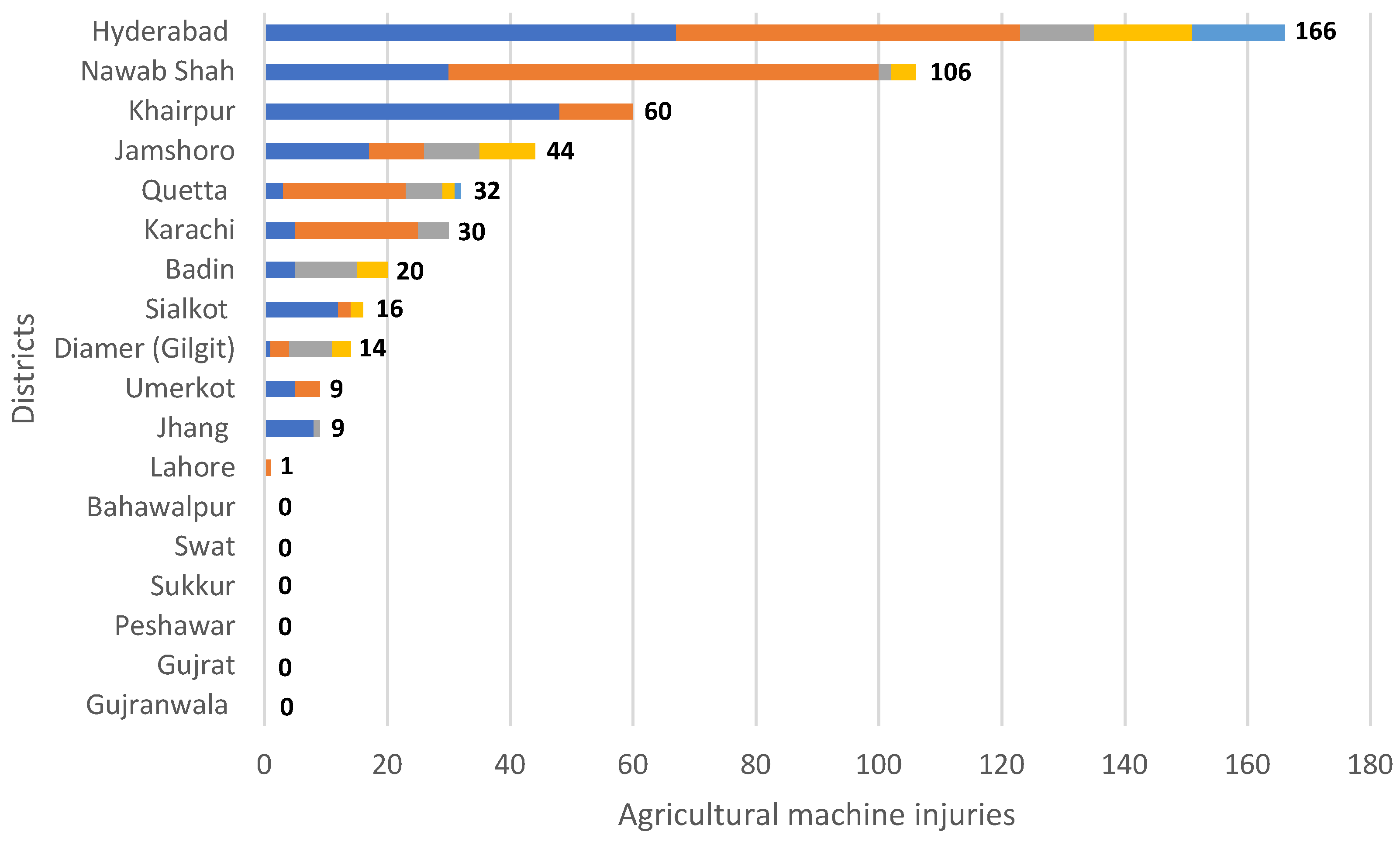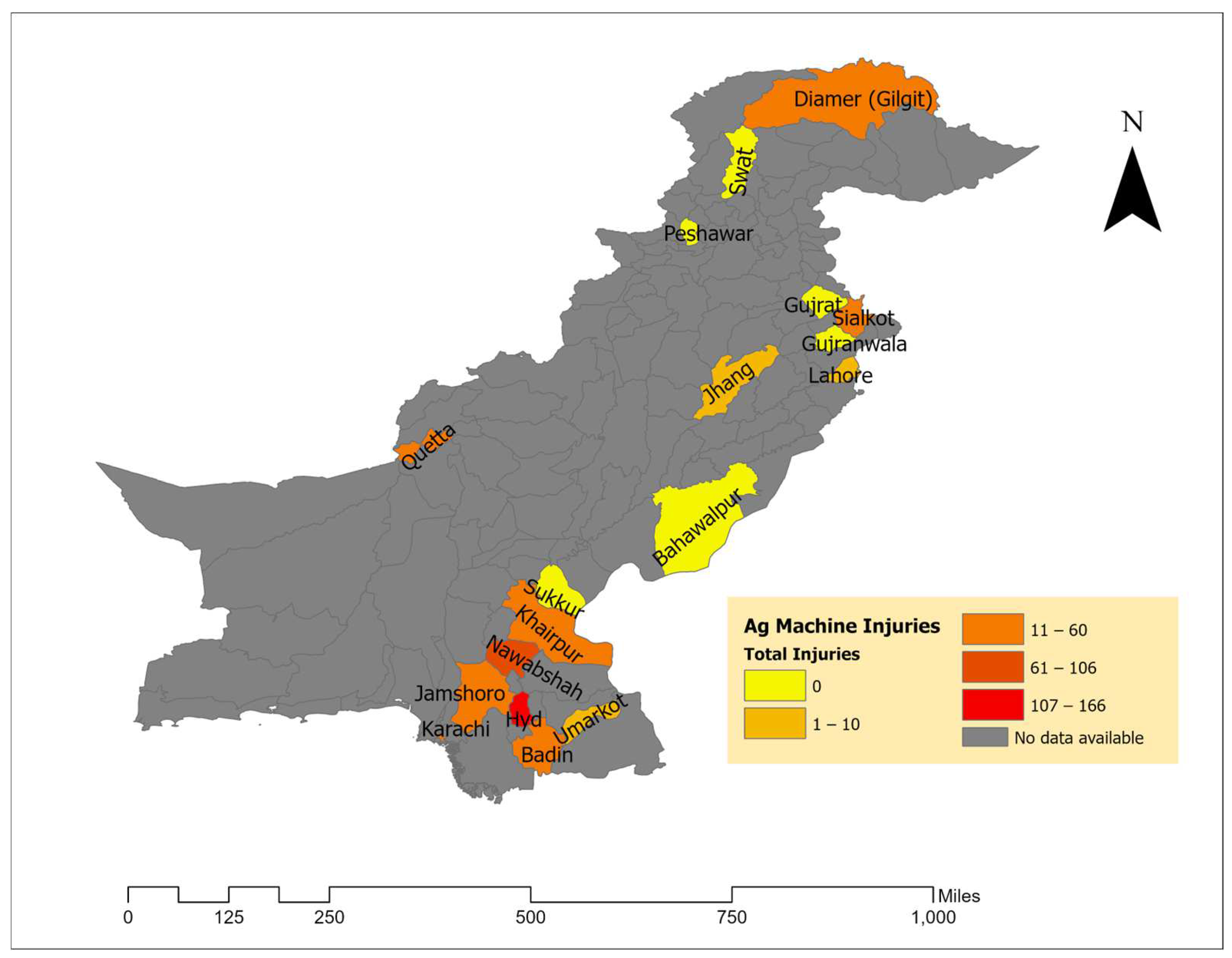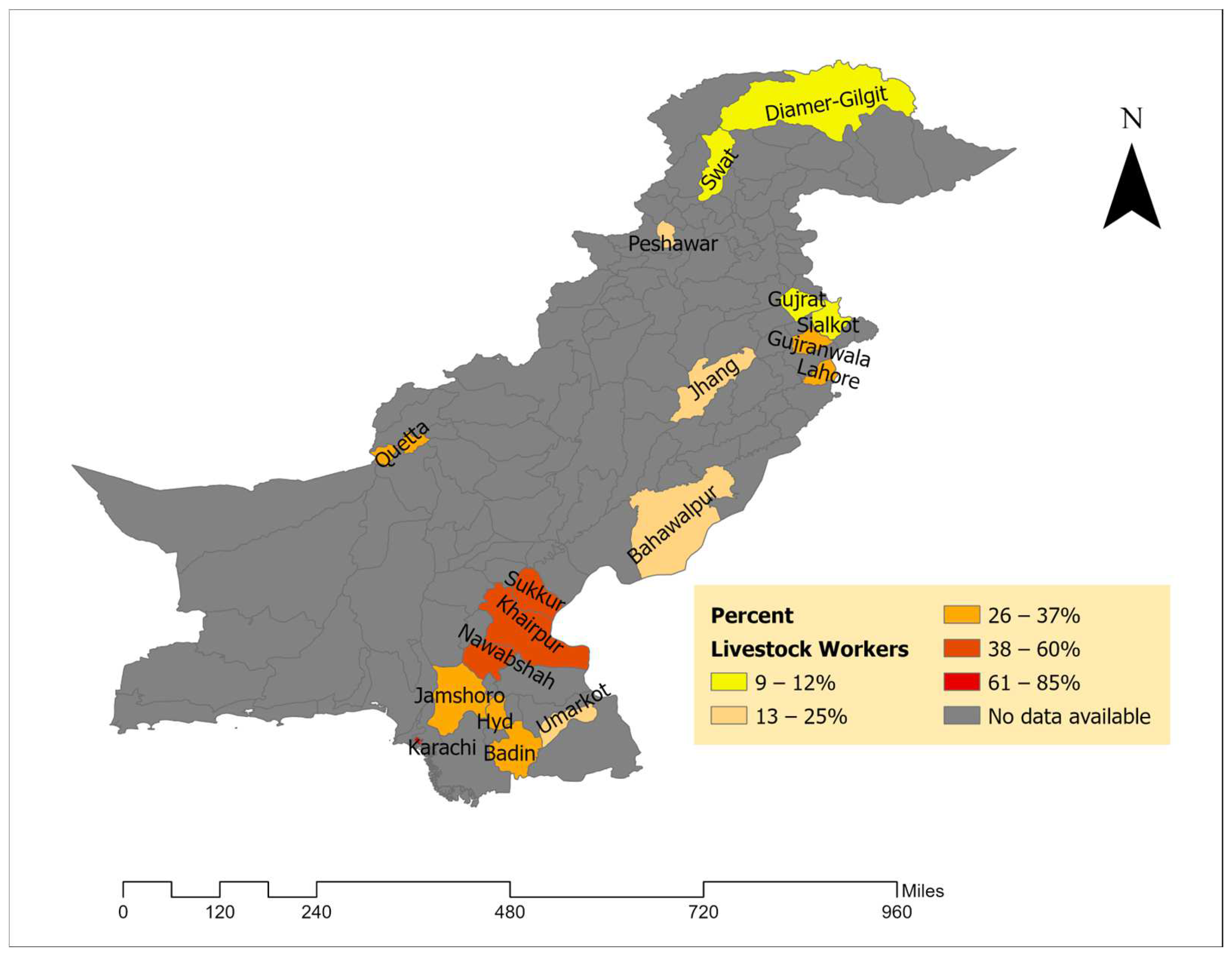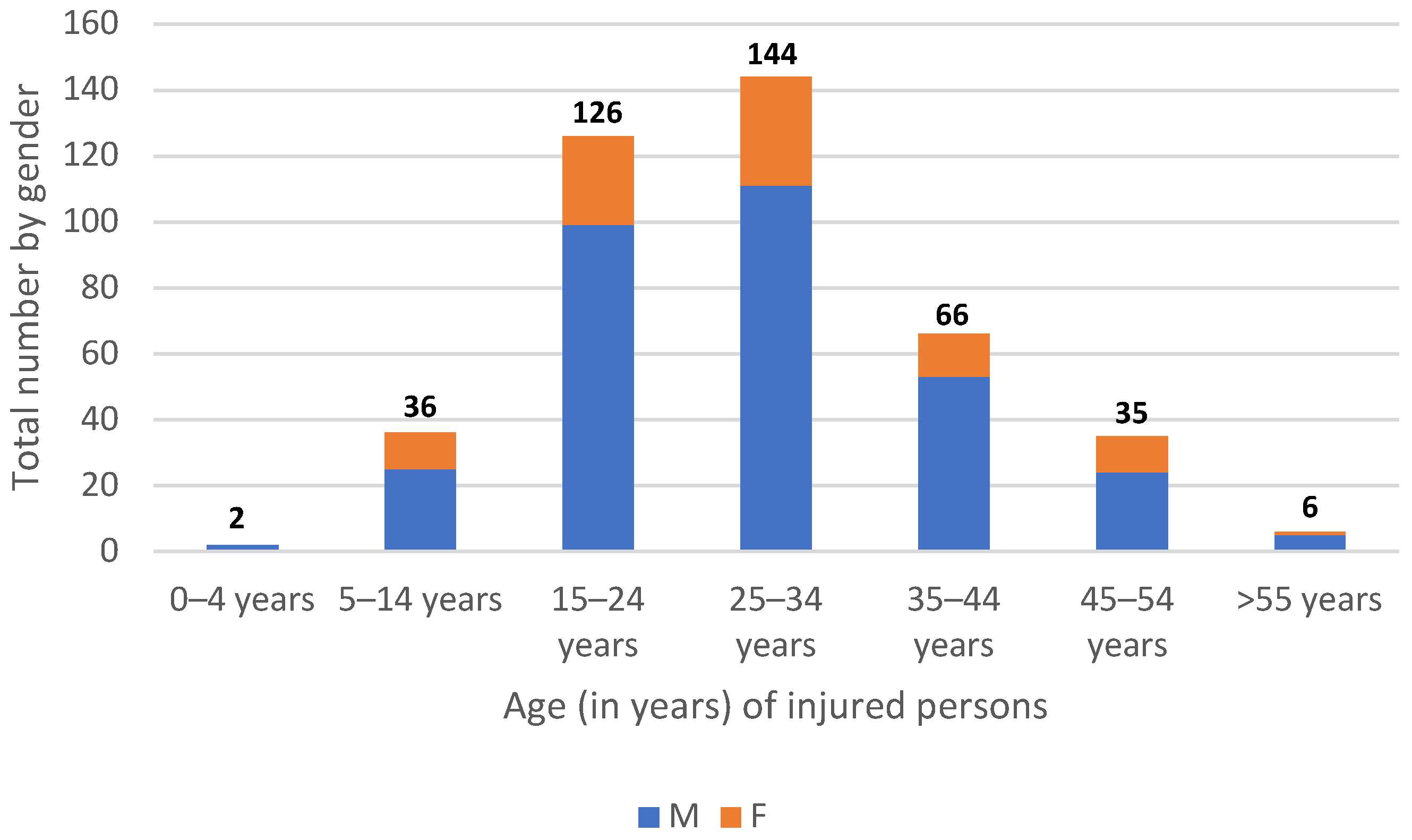Insights into Agricultural Machine Injuries in Pakistan: An Orthopedic Surgeons Survey (2022–2023)
Abstract
1. Introduction
2. Materials and Methods
2.1. Survey Instruments
- How many farm-related injuries occurred to each operator/worker from November to April?
- How many of the agriculture patients you receive were (age group)?
- How many of the agriculture patient you receive were due to (source of injury)
- How many of the agriculture patient you receive were due to (type of injury)?
2.2. Recruitment
2.3. Survey Delivery
2.4. Data Analysis
2.5. Datasets
2.6. IRB Approval
3. Results
3.1. Major Sources of Injuries
3.2. Visualization of Injuries by District in Pakistan
3.3. Nature of Agricultural Injuries
3.4. Agricultural Machine Injuries by Gender and Age
4. Discussion
4.1. Type of Equipment
4.2. Injury Distribution by District
4.3. Injury Type
4.4. Injury by Demographic
4.5. Seasonality of Injuries
5. Conclusions
6. Study Limitations
Author Contributions
Funding
Institutional Review Board Statement
Informed Consent Statement
Data Availability Statement
Acknowledgments
Conflicts of Interest
References
- Employment Indicators 2000–2019 (Global and Regional Trends). Food and Agriculture Organization of the United Nations. (n.d.). Available online: https://www.fao.org/statistics/highlights-archive/highlights-detail/New-FAOSTAT-data-release-Employment-indicators-2000-2019-(Global-and-regional-trends)/en (accessed on 14 April 2024).
- Qaisrani, M.I.; Baig, N.; Rathore, T.; Yousuf, F. Occupational Health Hazards of livestock workers in Pakistan. Pak. J. Public Health 2018, 8, 52–57. [Google Scholar] [CrossRef][Green Version]
- Asha, K.R.; Kumar, A.; Singh, J.K.; Kushwaha, H.; Kushwaha, D.K.; Bhowmik, A. Sensor-based safety alarm system for injury prevention in Chaff Cutter Machine. Smart Agric. Technol. 2023, 5, 100282. [Google Scholar] [CrossRef]
- Pakistan—Labour Force Survey 2014–2015. 14 April 2024. Available online: https://webapps.ilo.org/surveyLib/index.php/catalog/6839/related-materials (accessed on 14 April 2024).
- Pakistan Bureau of Statistics. Labour Force Survey 2021. Pakistan—Labour Force Survey 2021. 14 April 2024. Available online: https://webapps.ilo.org/surveyLib/index.php/catalog/7929 (accessed on 14 April 2024).
- Ch, N.A.; Azeem, M.; Iqbal, M.Z.; Ch, A.A. Fodder Cutter Amputations-Evaluation of Risk Factors. J. Pak. Orthop. Assoc. 2016, 28, 46–49. [Google Scholar]
- Ahmed, S.; Hamid, K.; Shabir, F.; Latif, A. Pattern of Fodder Cutting Machine Injuries in Sialkot Region. Pak. J. Med. Health Sci. 2018, 12, 220–224. [Google Scholar]
- Zulfiqar, Z.; Bubak, S.Z.; Jahangir, A.; Ali, Z. Frequency of traumatic amputation of upper extremity presenting at tertiary care hospital in Southern Punjab Pakistan. Med. Forum 2018, 29, 60. [Google Scholar]
- Tunio, Z.H.; Jhatiyal, R.A.; Jokhio, M.F.; Ali, S.M.; Baloch, R.A.; Makhdoom, A. Fodder Cutter Machine Injuries: An Unsafe Household Item in Rural Sindh in Pakistan. J. Liaquat Univ. Med. Health Sci. 2021, 20, 96–99. [Google Scholar]
- Ali, D.; Kaiser, M.A.; Khokhar, M.I.; Zeb, A.; Zaheer, H.; Afzal, M.F. Fodder Cutter (Tokka) injuries; a preventable morbidity. J. Pak. Med. Assoc. 2020, 71, 1022–1024. [Google Scholar] [CrossRef]
- Bhatti, S.H.; Abbasi, M.K.; Naqvi AS, A.H. Pattern of fodder cutting machine injury in Gambat region, Sindh, Pakistan. Rawal Med. J. 2021, 46, 560. [Google Scholar]
- Rabbani, U.; Fatmi, Z. Incidence, patterns and associated factors for occupational injuries among agricultural workers in a developing country. Med. J. Islam. Repub. Iran 2018, 32, 88. [Google Scholar] [CrossRef]
- Chopra, S.; Kumar, P.; Kumar, M. Severity of agricultural injuries and its economic consequences in border belt of Gurdaspur District of Punjab, India. J. Agromedicine 2023, 29, 179–188. [Google Scholar] [CrossRef]
- Noman, M.; Mujahid, N.; Fatima, A. The assessment of occupational injuries of workers in Pakistan. Saf. Health Work. 2021, 12, 452–461. [Google Scholar] [CrossRef] [PubMed]
- Jarén, C.; Ibarrola, A.; Mangado, T.; Adin, A.; Arnal, P.; López-Maestresalas, A.; Ríos, A.; Arazuri, S. Fatal tractor accidents in the agricultural sector in Spain during the past decade. Agronomy 2022, 12, 1694. [Google Scholar] [CrossRef]
- Kim, K.; Kim, H.; Lee, M.; Jung, W.; Choi, D. Incidence rates of agricultural machine-related injuries in South Korea. Int. J. Environ. Res. Public Health 2022, 19, 15588. [Google Scholar] [CrossRef]
- Kogler, R.; Quendler, E.; Boxberger, J. Occupational accidents with agricultural machinery in Austria. J. Agromed. 2016, 21, 61–70. [Google Scholar] [CrossRef] [PubMed]
- Shaver, J.; McRoberts, D.; O’Byrne, B.; Morgan, B.; Krall, K.; Surjan, C.; Mayberry, J. Farming and ranching related injuries in Southern Idaho. Am. J. Surg. 2017, 213, 881–884. [Google Scholar] [CrossRef]
- FAO in Pakistan|Food and Agriculture Organization of the United Nations. Available online: http://www.fao.org/pakistan/our-office/pakistan-at-a-glance/en/ (accessed on 14 April 2024).
- Climate-Smart Agriculture in Pakistan. (n.d.). Available online: https://climateknowledgeportal.worldbank.org/sites/default/files/2019-06/CSA-in-Pakistan.pdf (accessed on 14 April 2024).
- Iqbal, M.A.; Iqbal, A.; Afzal, S.; Akbar, N.; Abbas, R.N.; Khan, H.Z. In Pakistan, agricultural mechanization status and future prospects. Am.-Eurasian J. Agric. Environ. Sci. 2015, 15, 122–128. [Google Scholar]
- Raza, M.M.; Li, S.; Issa, S.F. Global patterns of agricultural machine and equipment injuries—A systematic literature review. J. Agromed. 2024, 29, 214–234. [Google Scholar] [CrossRef]
- Illinois.qualtrics.com. (n.d.). Available online: https://illinois.qualtrics.com/homepage/ui (accessed on 14 April 2024).
- Singh, R.; Sharma, A.; Jain, S.; Sharma, S.; Magu, N. Wheat Thresher Agricultural Injuries: A by-product of mechanised farming. Asia Pac. J. Public Health 2005, 17, 36–39. [Google Scholar] [CrossRef]
- Pakistan Orthopedic Association. 11 February 2024. Available online: http://p-o-a.org/ (accessed on 11 February 2024).
- Agricultural Census 2010—Pakistan Report|Pakistan Bureau of Statistics. (n.d.). Available online: https://www.pbs.gov.pk/publication/agricultural-census-2010-pakistan-report (accessed on 5 May 2024).
- Publications and Reports. Bureau of Statistics, Punjab. 14 June 2023. Available online: https://bos.punjab.gov.pk/publicationreports#PHS (accessed on 14 April 2024).
- Statistics: Sindh Bureau of Statistics. 2022. Available online: https://sbos.sindh.gov.pk/ (accessed on 14 April 2024).
- Amitha, P.; Binu, V.S.; Seena, B. Estimation of missing values in aggregate level spatial data. Clin. Epidemiol. Glob. Health 2021, 9, 304–309. [Google Scholar] [CrossRef]
- Office of the Vice Chancellor for Research and Innovation. Notice of Not Human Subjects Research Determination. 12 April 2023. Available online: https://oprs.research.illinois.edu/ (accessed on 12 April 2024).
- Rabbani, M.J.; Haq, A.U.; Aslam, F.; Khan, H.; Tarar, M.N. Fodder cutter (Toka) injuries, a preventable tragedy. Our experience at Jinnah Hospital Lahore. Pak. J. Plast. Surg. 2012, 1, 13–20. [Google Scholar]
- Kumar, A.; Singh, J.K.; Singh, C. Prevention of chaff cutter injuries in rural India. Int. J. Inj. Control Saf. Promot. 2013, 20, 59–67. [Google Scholar] [CrossRef] [PubMed]
- Wanjara, S.; Oduor, P. Hand injuries in Kenya: A Chaff Cutter Menace. F1000Research 2022, 11, 1255. [Google Scholar] [CrossRef] [PubMed]
- Shrestha, K.M.; Shrestha, B.; Kandel, P.R.; Baral, R.; Pandey, A.; Singh, G.P. Fodder cutter machine injuries of hand. J. Univers. Coll. Med. Sci. 2018, 6, 14–18. [Google Scholar] [CrossRef]
- Kumar, A.; Varghese, M.; Mohan, D. Equipment-related injuries in agriculture: An international perspective. Inj. Control. Saf. Promot. 2000, 7, 175–186. [Google Scholar] [CrossRef]
- Mayrhofer, H.; Quendler, E.; Boxberger, J. Occupational incidents with self-propelled machinery in Austrian agriculture. J. Agromed. 2013, 18, 359–367. [Google Scholar] [CrossRef]






| Province | Department | Gender | Fatality | Source of Injury | Type of Injury | Age Group | Month |
|---|---|---|---|---|---|---|---|
| Sindh | Emergency | Male | Yes | Fodder cutter | Laceration | 0–4 | November |
| Punjab | Orthopedic | Female | No | Thresher | Amputation | 5–14 | December |
| Balochistan | Other | Tractor | Fracture | 15–24 | January | ||
| Khyber Pakhtunkhwa | Tractor Trolley | Crushed | 25–34 | February | |||
| Gilgit | Power takeoff | Burns | 35–44 | March | |||
| Hand tools | Bruise | 45–54 | April | ||||
| Portable cutter | Cut | >55 | |||||
| Other | Sprain | ||||||
| Pinch | |||||||
| Other |
| Province | Farm Family Workers | Livestock Family Workers | Hired Workers | Total |
|---|---|---|---|---|
| Punjab | 5,296,964 | 2,008,041 | 20,400,250 | 27,705,255 |
| Sindh | 3,553,909 | 2,722,747 | 5,206,730 | 11,483,386 |
| KPK | 1,554,608 | 353,876 | 2,523,520 | 4,432,004 |
| Baluchistan | 1,039,588 | 352,741 | 539,928 | 1,932,257 |
| Total | 11,445,069 | 5,437,405 | 28,670,428 | 45,552,902 |
| Districts | Number of Injuries | Survey Respondents | Survey Respondents with >0 Injuries Reported | Number of Government Hospitals with DHQ and Emergency Department | Number of Trauma Centers | Family Workers | Hired Workers |
|---|---|---|---|---|---|---|---|
| Quetta | 32 | 4 | 3 | 2 | 0 | 18,708 | |
| Karachi | 30 | 3 | 1 | 11 | 3 | 20,152 | 6774 |
| Hyderabad | 166 | 16 | 8 | 9 | 1 | 137,996 | 108,645 |
| Jamshoro | 44 | 4 | 2 | 4 | 0 | 61,928 | 19,858 |
| Gilgit | 14 | 1 | 1 | 5 | 1 | * | * |
| Nawab Shah | 106 | 3 | 3 | 2 | 0 | 317,336 | 165,492 |
| Khairpur | 60 | 3 | 2 | 2 | 0 | 808,887 | 392,068 |
| Badin | 20 | 1 | 1 | 5 | 0 | 284,789 | 98,009 |
| Sialkot | 16 | 2 | 2 | 8 | 0 | 475,123 | 146,692 |
| Umerkot | 9 | 1 | 1 | 5 | 0 | 278,697 | 221,074 |
| Jhang | 9 | 1 | 1 | 8 | 1 | 564,534 | 362,310 |
| Lahore | 1 | 3 | 1 | 72 | 0 | 181,790 | 255,286 |
| Gujranwala | 0 | 1 | 0 | 21 | 0 | 345,058 | 428,256 |
| Gujrat | 0 | 1 | 0 | 16 | 1 | 320,221 | 147,724 |
| Peshawar | 0 | 2 | 0 | 4 | 1 | 211,508 | 173,411 |
| Sukkur | 0 | 3 | 0 | 4 | 2 | 242,026 | 53,513 |
| Swat | 0 | 4 | 0 | 1 | 0 | 279,716 | 150,927 |
| Bahawalpur | 0 | 2 | 0 | 12 | 0 | 547,729 | 534,173 |
| Total | 507 | 55 | 26 | 191 | 10 | 5,118,472 | 3,264,212 |
Disclaimer/Publisher’s Note: The statements, opinions and data contained in all publications are solely those of the individual author(s) and contributor(s) and not of MDPI and/or the editor(s). MDPI and/or the editor(s) disclaim responsibility for any injury to people or property resulting from any ideas, methods, instructions or products referred to in the content. |
© 2024 by the authors. Licensee MDPI, Basel, Switzerland. This article is an open access article distributed under the terms and conditions of the Creative Commons Attribution (CC BY) license (https://creativecommons.org/licenses/by/4.0/).
Share and Cite
Raza, M.M.S.; Tunio, Z.H.; Ujjan, I.D.; Issa, S.F. Insights into Agricultural Machine Injuries in Pakistan: An Orthopedic Surgeons Survey (2022–2023). Safety 2024, 10, 55. https://doi.org/10.3390/safety10030055
Raza MMS, Tunio ZH, Ujjan ID, Issa SF. Insights into Agricultural Machine Injuries in Pakistan: An Orthopedic Surgeons Survey (2022–2023). Safety. 2024; 10(3):55. https://doi.org/10.3390/safety10030055
Chicago/Turabian StyleRaza, Mian Muhammad Sajid, Zamir Hussain Tunio, Ikram Din Ujjan, and Salah F. Issa. 2024. "Insights into Agricultural Machine Injuries in Pakistan: An Orthopedic Surgeons Survey (2022–2023)" Safety 10, no. 3: 55. https://doi.org/10.3390/safety10030055
APA StyleRaza, M. M. S., Tunio, Z. H., Ujjan, I. D., & Issa, S. F. (2024). Insights into Agricultural Machine Injuries in Pakistan: An Orthopedic Surgeons Survey (2022–2023). Safety, 10(3), 55. https://doi.org/10.3390/safety10030055






